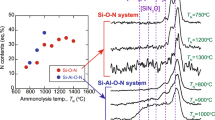Abstract
Oxygen (O) diffusion through pure and aluminum (Al)-doped amorphous silica is investigated by using secondary ion mass spectrometry to profile the diffusion of an18O tracer. The oxides are formed by the thermal oxidation of polymer-derived SiCN and SiAlCN ceramics. The authors demonstrate that a small amount of Al dopant can significantly inhibit both the interstitial and network diffusion of O. The activation energy of O network diffusion for Al-doped silica is two times higher than that for pure silica. The results are discussed in terms of the modification of Al doping on the network structure of the otherwise pure silica.
Similar content being viewed by others
References
J.C. Mikkelsen, Self-Diffusivity of Network Oxygen in Vitreous SiO2,Appl. Phys. Lett., 1984,45, p 1187–1189
H. Yinnon and A.R. Cooper, Oxygen Diffusion in Multicomponent Glass Forming Silicates,Phys. Chem. Glasses, 1980,21, p 204–211
H.A. Schaeffer and K. Muehlenbachs, Correlations Between Oxygen-Transport Phenomena in Non-Crystalline Silica,J. Mater. Sci., 1978,13, p 1146–1148
J.D. Kalen, R.S. Boyce, and J.D. Cawley, Oxygen Tracer Diffusion in Vitreous Silica,J. Am. Ceram. Soc., 1991,74, p 203–209
M.A. Lamkin, F.L. Riley, and R.J. Fordham, Oxygen Mobility in Silicon Dioxide and Silicate Glasses: A Review,J. Eur. Ceram. Soc., 1992,10, p 347–367
B.E. Deal and A.S. Grove, General Relationship for Thermal Oxidation of Silicon,J. Appl. Phys., 1965,36, p 3770–3778
N.S. Jacobson, Corrosion of Silicon-Based Ceramics in Combustion Environments,J. Am. Ceram. Soc., 1993,76, p 3–28
Z. Zheng, R.E. Tressler, and K.E. Spear, The Effect of Sodium Contamination on the Oxidation of Single-Crystal Silicon-Carbide,Corros. Sci., 1992,33, p 545–556
E. Opila, Influence of Alumina Reaction Tube Impurities on the Oxidation of Chemically-Vapor-Deposited Silicon-Carbide,J. Am. Ceram. Soc., 1995,78, p 1107–1110
R.E. Tressler, Theory and Experiment in Corrosion of Advanced Ceramics,Corrosion of Advanced Ceramics, K.G. Nickel, Ed., Kluwer Academic Publisher, Dordrecht, 1994, p 3–22
H. Rawson, Properties and Applications of Glass,Glass Science and Technology, Elsevier, North-Holland, 1980
L. An, Y. Wang, L. Bharadwaj, Y. Fan, L. Zhang, D. Jiang, Y. Sohn, V. Desai, J. Kapat, and L. Chow, Amorphous Silico-aluminum Carbonitride with Ultrahigh Oxidation/Hot-Corrosion Resistance,Adv. Eng. Mater., 2004,6(5), p 337–340
Y. Wang, Y. Fan, L. Zhang, S. Burton, Z. Gan, and L. An, Oxidation of Polymer-Derived SiAlCN Ceramics,J. Am. Ceram. Soc., 2005,88, p 3075–3080
L. Bharadwaj, Y. Fan, L. Zhang, D. Jiang, and L. An, Oxidation Behavior of A Fully Dense Polymer-Derived Amorphous Silicon Carbonitride Ceramic,J. Am. Ceram. Soc., 2004,87, p 483–486
A. Dhamne, W. Xu, B. Fookes, Y. Fan, L. Zhang, S. Burton, J. Hu, J. Ford, and L. An, Polymer-Ceramic Conversion of Liquid Polyaluminasilazanes for SiAlCN Ceramic,J. Am. Ceram. Soc., 2005,88, p 2415–2419
L. Bharadwaj, “Oxidation of Polymer-Derived Ceramics,” Master Thesis, University of Central Florida, 2004
J.A. Costello and R.E. Tressler, Isotope Labeling Studies of the Oxidation of Silicon at 1000-Degrees-C and 1300-Degrees-C,J. Electrochem. Soc., 1984,131, p 1944–1947
J.D. Cawley and R.S. Boyce, A Solution of the Diffusion Equation for Double Oxidation in Dry Oxygen Including Lazy Exchange Between Network and Interstitial Oxygen,Philos. Mag. A, 1988,4, p 589–601
J. Rodríguez-Viejo, F. Sibieude, M.T. Clavaguuera-Mora, and C. Monty, O-18 Diffusion Through Amorphous SiO2 and Cristobalite,Appl. Phys. Lett., 1993,63, p 1906–1908
S.V. King, Ring Configurations in a Random Network Model of Vitreous Silica,Nature, 1967,213, p 1112–1113
P. Umari and A. Pasquarello, Modeling of the Raman Spectrum of Vitreous Silica: Concentration of Small Ring Structures,Physica B, 2002,316–317, p 572–574
J.P. Rino, I. Ebbsjö, R.K. Kalia, A. Nakano, and P. Vashishta, Structure of Rings in Vitreous SiO2,Phys. Rev. B: Condens. Matter, 1993,47(6), p 3053–3062
K. Vollmayr, W. Kob, and K. Binder, Cooling-Rate Effects in Amorphous Silica: A Computer-Simulation Study,Phys. Rev. B: Condens. Matter, 1996,54(22), p 15808–15827
T. Bakos, S.N. Rashkeev, and S.T. Pantelides, Reactions and Diffusion of Water and Oxygen Molecules in Amorphous SiO2,Phys. Rev. Lett., 2002,88, 055508
Author information
Authors and Affiliations
Rights and permissions
About this article
Cite this article
Wang, Y., Sohn, Y., An, L. et al. Oxygen diffusion through Al-doped amorphous SiO2 . JPED 27, 671–675 (2006). https://doi.org/10.1007/BF02736571
Received:
Revised:
Issue Date:
DOI: https://doi.org/10.1007/BF02736571




